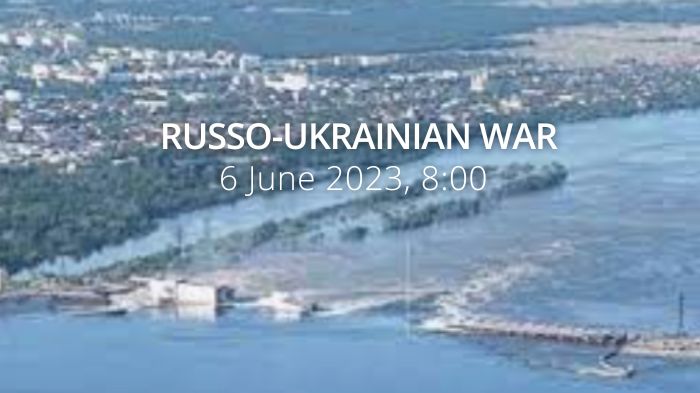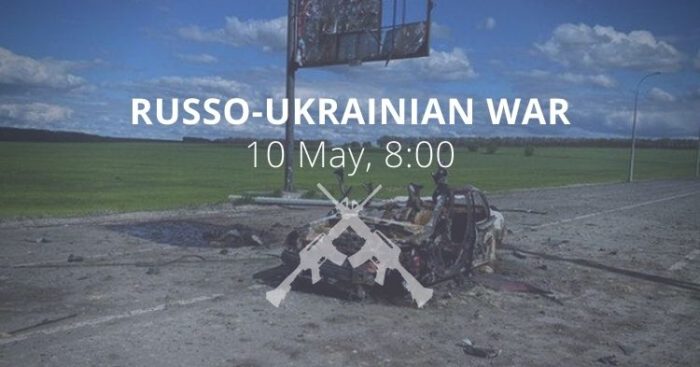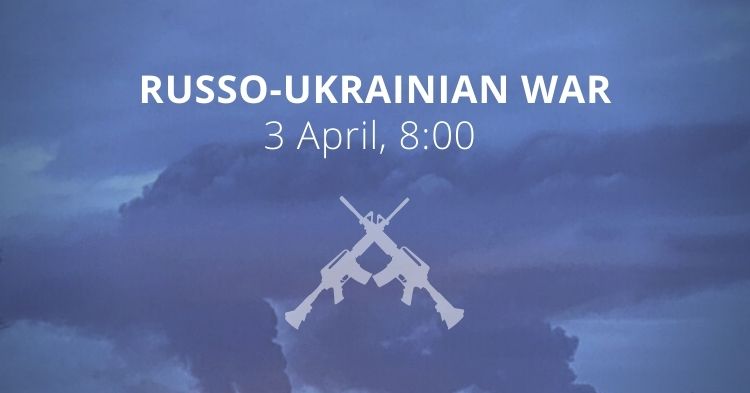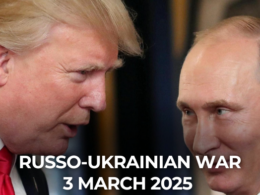The report is based on media reports, expert analyses, and official information posted online.
Situation
According to information from the General Staff as of 06.00 01.04.2022, supplemented by its [midnight assessment]. Additionally, I have added information of relevance from yesterday afternoon and evening [[grey text]]:
[[There is a threat of Russian use of missiles against the defence-industrial complex and logistical infrastructure of Ukraine. Additional units of the armed forces of the Russian Federation are being relocated to Ukraine to conduct hostilities. At the same time, some military units of the Russian enemy have already exhausted the possibilities of forming reserves.]] [The Russian forces, having suffered significant losses in personnel and equipment, did not succeed in blocking and capturing the city of Kyiv. The occupiers were forced to temporarily abandon this task.] [In the Volyn direction it is without changes. Russia brought up to 5 Battalion Tactical Groups (BTGs) to the territory of the Republic of Belarus.] The units of the Russian occupation forces continue to partially withdraw from the north of Kyiv oblast towards the state border with the Republic of Belarus. It is noted the movement of joint columns of equipment of different quantities of Russian enemy. The convoys also include civilian vehicles (trucks, buses, minibuses, cars) that were stolen by Russian invaders during the temporary occupation of the territories. In addition, the enemy carries out the removal of looted property. Russian forces around Kyiv are retreating en masse, leaving behind wrecked armour and possibly trapped pockets of troops as the Ukrainian army advances. This map shows settlements confirmed recaptured today (blue) and yesterday (yellow). The siege of Chernihiv is also lifted. pic.twitter.com/eINXgPpyJr — Nathan Ruser (@Nrg8000) April 1, 2022 [In the Polissya direction, the Russian forces are regrouping troops.] [[In the Brovary direction, the enemy continues to withdraw units, probably to the border areas with the Russian federation.]] [In the Siversky direction, the occupiers are withdrawing part of the troops under the cover of individual units of the 1st Tank Army.] [In the Slobozhansky direction, the Russian forces continue to blockade the city of Kharkiv, launching artillery shelling to destroy the city's infrastructure and residential areas. In the area south of the city of Izium, the Russian forces are trying to break the resistance of Ukrainian defenders, expel units of the Defence Forces from their positions and continue the offensive in the direction of Sloviansk. It is not successful.] [The Russian forces did not conduct active offensive operations in the Donetsk direction. The forces focused on continuing the assault on the city of Mariupol. It expanded the grouping of the 58th All-Military Army by introducing the BTGr, which was made up of servicemen transferred from the 7th Military Base (Abkhazia).] [[In the Tavriya direction, near Nova Kakhovka, the enemy deployed a logistics base and does not take active action.]] The Russian forces tried to carry out offensive actions in the direction of the settlement of Alexandrovka in the Mykolayiv area.] [The Russian forces continue to strengthen groups of troops at the expense of units of the Eastern Military District. It is trying to form occupation administrations within the temporarily occupied districts of Donetsk, Luhansk, Zaporizhzhia and Kherson oblasts.] [In view of the above, the Russian forces are likely to try to maintain a military presence in the southern and eastern regions of Ukraine in the near future.] [[Leaving military equipment on the territory of Ukraine, the occupiers are increasingly resorting to its mining. In addition, the use of mine traps by the enemy has become more frequent.]] [The Defensive Forces of Ukraine continues to conduct a defence operation in the Eastern, Southeastern and Northeastern directions. Stabilization operations are being carried out in other areas, and territorial defence tasks are being carried out.] [Ukraine's Defence Forces continue to successfully carry out their tasks, pursue the retreating forces, break through the Russian occupiers' defensive positions and gradually liberate Ukrainian lands.] Ukraine's Defence Forces continue to successfully carry out their tasks, pursue the retreating enemy, break through the occupiers' defensive positions and gradually liberate Ukrainian lands.” 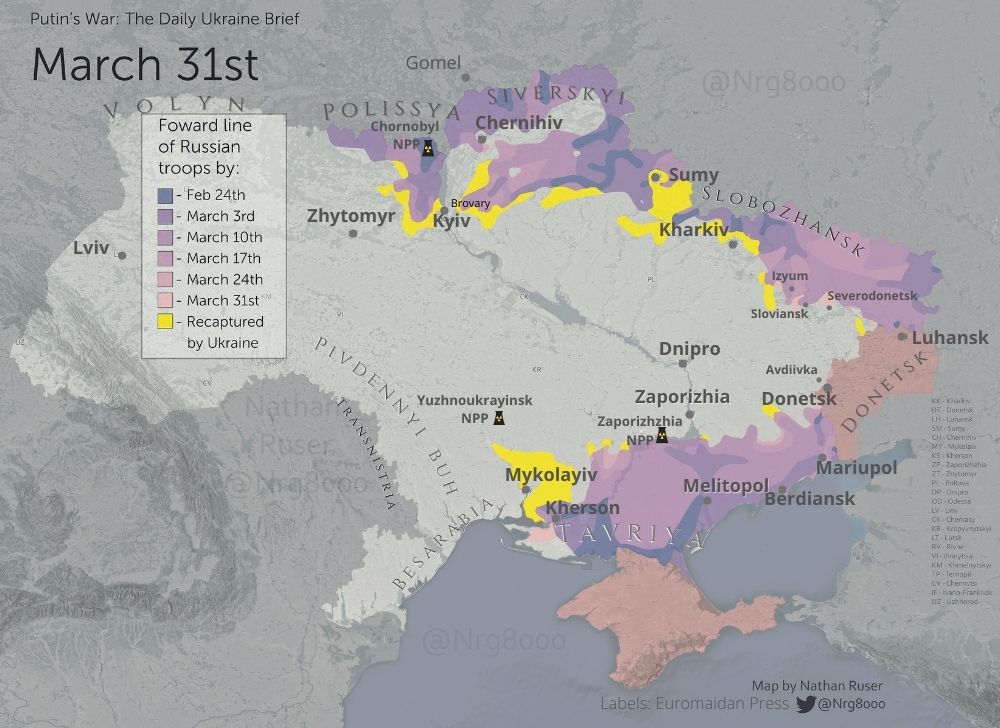
To highlight the significance of the past week, here is a gif showing changes compared to a similar map I made last week. All the areas circled in blue are where Ukrainian forces have gained territory, in red shows where Russian forces have.
(ignore the changing colour scale) pic.twitter.com/qDNAEx0OMs— Nathan Ruser (@Nrg8000) March 31, 2022
In Russia's Belgorod, a fire broke out at an oil depot, two workers were injured - region's authorities. Belgorod Governor Vyacheslav Gladkov stated that the fire broke out due to an air strike from two Ukrainian helicopters. Ukrainian officials have not confirmed this yet:
In Russia's Belgorod, a fire broke out at an oil depot, two workers were injured - region's authorities.
Belgorod Governor Vyacheslav Gladkov states that the fire broke out due to an air strike from two Ukrainian helicopters. https://t.co/d3pv2Pyqic pic.twitter.com/TjeYm9rEd5
— Euromaidan Press (@EuromaidanPress) April 1, 2022
During the last 24 hours, the Ukrainian General Staff has reported on the Russian manning and logistic challenges:
- The practice of submitting applications to the judiciary for military leadership by relatives of Russian servicemen killed in the war with Ukraine has begun in the Russian Federation. In particular, a similar case of filing a lawsuit against the commander was recorded in the 752nd Motorized Rifle Regiment of the 3rd Motorized Rifle Division of the 20th All-Military Army of the Western Military District.
- [According to the available information, during the fighting against Ukraine, the losses of the 1st Motorized Rifle Battalion of the 36th Separate Motorized Rifle Brigade (unit 06705, Borzya) of the 29th All-Military Army accounted for more than 60% of the personnel.]
According to British Defence Intelligence, (last 24 hours):
- Ukrainian forces have retaken the villages of Sloboda and Lukashivka to the south of Chernihiv and located along one of the main supply routes between the city and Kyiv.
- Ukraine has also continued to make successful but limited counter attacks to the east and northeast of Kyiv.
- Both Chernihiv and Kyiv have been subjected to continued air and missile strikes despite Russian claims of reducing activity in these areas.
- Russia is redeploying elements of its forces from Georgia to reinforce its invasion of Ukraine.
- Between 1,200 and 2,000 of these Russian troops are being reorganised into 3 x Battalion Tactical Groups.
- It is highly unlikely that Russia planned to generate reinforcements in this manner and it is indicative of the unexpected losses it has sustained during the invasion.
Or, a video showing the areas under control every day since March 22nd. The same disclaimers apply.
I'll put some close-up crops of the key areas in the tweets below. pic.twitter.com/j0UDs03iwR— Nathan Ruser (@Nrg8000) March 31, 2022
As of Wednesday 31.03.2022, the approximate losses of weapons and military equipment of the Russian Armed Forces from the beginning of the war to the present day:
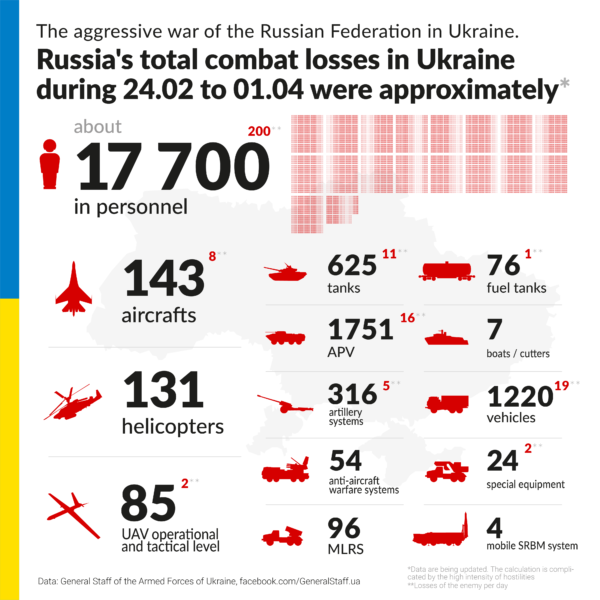
- personnel – more than 17,500 people (+200),
- tanks – 614 units (+9),
- armoured combat vehicles – 1735 units (+13),
- artillery systems – 311 (+6),
- multiple rocket launchers – 96 (no change)
- air defence means – 54 (no change),
- aircraft - 135 (+4),
- helicopters - 131 (+2),
- automotive technology – 1201 (+17),
- vessels/boats - 7 units (no change),
- fuel and lubricant tanks – 75 (no change),
- UAV operational and tactical level – 83 (+2)
- Special equipment – 22 (+1)
- Mobile SRBM system – 4 (no change)
Humanitarian
According to UNHCR 4,059,105 refugees have been registered as of March 30. The UN says that so far Poland has taken in 2,362,044 refugees, Romania 616,592, the Republic of Moldova 388,837, Hungary 368,807, Russia 350,632 (no changes since March 29), Slovakia 283,824 and Belarus 11,821.
As of midnight of March 30, OHCHR recorded 3,167 civilian casualties in Ukraine: 1,232 killed (including 112 children) and 1,935 injured (including 149 children).
Office of the Prosecutor General of Ukraine reports that as of 8 a.m. on April 1, 2022, since the beginning of the Russian invasion of Ukraine, 153 children were killed and more than 245 children - injured. It is still impossible to establish the actual number of dead and wounded due to the ongoing combat operations happening in Ukrainian cities.
All three agreed humanitarian corridors operated on March 31. This allowed the evacuation of 1458 civilians in total from Mariupol, Berdiansk, Melitopol, Enerhodar, Polohy, Orykhiv, Hulaypole and Vasylivka. Only private transport was, however, let through. Russian forces blocked Ukrainian evacuation buses. According to the Deputy Prime Minister and Minister of Reintegration of Temporarily Occupied Territories of Ukraine:
“Today, 45 buses arrived in Berdiansk for evacuation - the Deputy Prime Minister added. - But the occupiers did not let them enter the city. 600 people got on buses from the city and have to leave for Zaporizhzhia tomorrow morning. More than 30 buses remain at the entrance to Berdiansk to pick up Mariupol and Berdiansk residents in Zaporizhzhia in the morning. 12 buses for evacuation of people, loaded with 14 tons of food and medicine, arrived from Melitopol today. Unfortunately, it was taken away by the Russian forces.”
Legal
Overall registered numbers of crimes: 3701 crimes
of aggression and war crimes, and 2057 crimes against national security.

According to the General Staff of Ukraine:
- In the temporarily occupied territories, the Russian forces continues their illegal actions, restricting the movement of civilians, using the houses and apartments of local residents to accommodate personnel, holding residents and activists hostages. Marauding and violence against Ukrainian citizens continue.
- In some temporarily occupied by the Russian enemy areas, the Russian occupiers are trying to force entrepreneurs to switch to paying for goods and services in Russian rubles.
Support
The USA announced additional sanctions on Russian technology companies that enable Putin’s war of choice, on Thursday. According to the White House, the USA will prevent Russia from procuring Western technology and evading our severe sanctions. It is also expanding its sanctions authority to target additional sectors of the Russian economy important to Putin, including aerospace, maritime, and electronics sectors.
“In the coming days, the Commerce Department will also take further action to degrade Russia’s defence, aerospace, and maritime sectors by adding 120 entities in Russia and Belarus to the Entity List, bringing the number of Russian and Belarusian parties added to the list to over 200 since the invasion began. Being added to this list means that these entities can no longer get US cutting-edge technology without a license, which will — which will in most, if not all, of these cases be denied.
Compared to the same time period last year, US exports to Russia of items subject to our new export controls have decreased by 99 percent by value. The power of these restrictions will compound over time as Russia draws down any remaining stockpiles — for example, spare parts for certain planes and tanks. We will continue to impose unprecedented costs, strengthen Ukraine’s hand, and make Putin’s war of choice a strategic failure.”
Can the US and NATO provide Ukraine with enough weapons, NBC News asks?
“Russia’s faltering campaign in Ukraine and the relative success of Ukrainian forces in fending off the invasion have forced the US and other NATO governments to consider providing military aid for Kyiv on a scale Western leaders never anticipated, current and former officials say. The White House says that it has moved swiftly in an unprecedented way to get weapons in the hands of Ukrainians fighting the Russian troops and that US officials are working with NATO allies to keep the arms moving to Ukraine. It’s not clear, however, that the US and other NATO members can sustain even the current level of weapons deliveries. … these commitments threaten to deplete the existing supplies of some munitions, according to John Schaus of the Center for Strategic and International Studies think tank. Under recent decisions, the United States will deliver about 4,600 Javelin anti-tank missiles to Ukraine, the White House says. That would account for more than half of the 8,885 Javelins the Defense Department bought in the past 10 years, said Schaus.”
The assessment is connected to some of the weapon systems delivered until now, and does, therefore, despite the negative headline, not reflect other defence support that might be on the verge of materialising.
Britain’s defence secretary has said western nations have agreed to send armoured vehicles and long-range artillery to Ukraine, at a special donor conference attended by more than 35 countries, including the US, The Guardian reports.
“Ben Wallace, who convened the event, said there would be “more lethal aid going into Ukraine” but that it would not include tanks or some of the other more deadly weapons that Ukraine’s president, Volodymyr Zelensky, had asked for in the past week. He said Ukraine needed longer-range artillery to counter Russian attacks on its cities, including Mariupol in the south, which has been subjected to relentless shelling. The best counter to that is other long-range artillery, so they’ll be looking for and getting more long-range artillery, ammunition predominantly, he said in an interview after the conference concluded. Ukraine was also “looking for armoured vehicles of some types, not tanks necessarily, but certainly protective vehicles, and more anti-air, Wallace said. All of this will be forthcoming as a result of this conference.”
New developments
- Peace negotiations between Moscow and Kyiv will resume on Friday, a senior Ukrainian official has said, amid mounting western scepticism about Russia’s intentions in the talks more than five weeks into its invasion of Ukraine, The Guardian reports.
“A Ukrainian negotiator, David Arakhamia, said on Thursday that talks would continue by video, focusing on the peace framework the Ukrainian side presented during a face-to-face meeting in Istanbul this week that Moscow described as constructive. Russia’s foreign ministry said Moscow would not refuse a separate meeting between the foreign minister, Sergei Lavrov, and his Ukrainian counterpart, Dmytro Kuleba, providing the talks between them were “substantive”. Kyiv and its allies have cast doubts, however, on Russia’s commitment to talks, noting there had been no real sign of the partial military pullback in northern Ukraine it had promised as a goodwill gesture and suggesting the Kremlin may be playing for time.” - Pessimism about Russia’s willingness to tame its attacks in Ukraine is growing amid mixed signals from Kremlin officials on peace talks and reports of new strikes near Kyiv and Chernihiv, where Russia had vowed to sharply reduce combat operations, The New York Times reports. “Russia’s lead negotiator said on Wednesday that peace talks with Ukraine appeared to be on the verge of a breakthrough, even as other officials voiced scepticism and pro-Kremlin commentators heaped scorn on the talks — mixed messages that underscored the lack of clarity over President Vladimir V. Putin’s goals in the invasion and the uncertainty over whether progress in the talks was real. The Kremlin’s chief negotiator, Vladimir Medinsky, read a statement broadcast on state television that described Ukraine’s proposal on Tuesday to declare neutrality as a core concession to Russia, just hours after the Kremlin’s spokesman, Dmitri S. Peskov, said that the talks in Istanbul had produced nothing very promising.”
- There has so far been no breakthrough in talks between Russia and Ukraine, French Foreign Minister Jean-Yves Le Drian said, TASS reports, citing an interview with the Le Figaro newspaper on Thursday. "I don’t see any signs indicating a real and long-term change in Russia’s position, he noted. Even though its troops are moving slower than the Kremlin expected, I don’t currently see any significant retreat or a ceasefire, Le Drian added.”
- The White House states that President Biden does not plan to reengage President Putin before Russia has demonstrated a significant de-escalation.
- The conflict between Russia and the West might be escalating. Russia will respond to European Union sanctions; the RIA news agency quoted a senior foreign ministry official on Friday. "The actions of the EU will not remain unanswered ... the irresponsible sanctions by Brussels are already negatively affecting the daily lives of ordinary Europeans," Nikolai Kobrinets told the news agency. Russian President Vladimir Putin played one of his biggest cards on Thursday, demanding European energy buyers start paying in roubles from Friday or have existing contracts halted. European governments rejected Putin's ultimatum, with the continent's biggest recipient of Russian gas, Germany, calling it "blackmail", Reuters reports.
Assessment On the War
The Institute for the Study of War has made the following assessment as of Thursday 31 March:
Russian efforts to redeploy damaged units from the Kyiv and Sumy axes to eastern Ukraine are unlikely to enable Russian forces to conduct major gains. Russia continued to withdraw elements of the 35th and 36th Combined Arms Armies and 76 Air Assault Division from their positions northwest of Kyiv into Belarus for refit and likely further redeployment to eastern Ukraine. However, these units are likely heavily damaged and demoralized. Feeding damaged Eastern Military District units directly into operations in eastern Ukraine—predominantly conducted by the Southern Military District—will likely prove ineffective and additionally introduce further command-and-control challenges for the Russian military. Russian forces will likely attempt to retain their current front lines around Kyiv and in northeastern Ukraine and will continue to dig in on these fronts; ISW has not seen any indicators of Russian forces fully relinquishing captured territory. However, Ukrainian counterattacks are likely disrupting Russian efforts to redeploy and refit their forces and will continue in the coming days.
Key Takeaways
- Ukrainian forces successfully conducted local counterattacks around Kyiv, towards Sumy, and in Kherson Oblast and will likely take further territory—particularly northwest and east of Kyiv—in the coming days.
- Russia is withdrawing elements of its damaged forces around Kyiv, Chernihiv, and Sumy for redeployment to eastern Ukraine, but these units are unlikely to provide a decisive shift in Russian combat power.
- Ukrainian forces continued to repel Russian assaults throughout Donetsk and Luhansk Oblasts, and Russian forces failed to take territory in the past 24 hours.
- Russian forces continue to steadily advance in Mariupol.
- Russia’s preplanned spring draft will begin on April 1 and does not appear abnormal from Russia’s typical conscription cycle. Newly drafted conscripts will not provide Russia with additional combat power for many months.
- The Kremlin is likely accelerating efforts to establish quasi-state entities to govern occupied Ukrainian territory.”
Putin has lost war thanks to catastrophic misjudgments, says British armed forces chief, the Independent reports. Admiral Sir Tony Radakin, the Chief of the Defence Staff, said:
“But in many ways, Putin has already lost. Far from being the far-sighted manipulator of events that he would have us believe, Putin has damaged himself through a series of catastrophic misjudgments.”
US and European officials said on Wednesday that Mr Putin had been misled by advisers who were too scared to tell him how poorly the conflict was going or how badly Western sanctions had hit Russia. […]
He told an event hosted by the Institute for Government think tank: “And lastly, he has failed to anticipate the unity and cohesion that exists among the free nations of the world, here in Europe and obviously far beyond.
“His actions to date have done more to galvanise than divide and have shown Ukraine to have the one thing Russia conspicuously lacks - real friends. […]
Admiral Radakin said Mr Putin’s ambitions to take Ukraine swiftly had fallen apart and that there were early indications that Russian forces were retreating, making the military open to attack from Ukrainian defenders.
He added: “It looks now that less emphasis is being placed on Kyiv and more emphasis is being placed on the east and the south.
“We are starting to see the early indications of those forces being moved back from Kyiv and retreating to both Russia and Belarus.
“That in itself is a difficult evolution for Russia because they are doing that under contact, so Ukraine armed forces will attack those Russian forces as they retreat.”
However, his analysis differs from that of NATO secretary-general Jens Stoltenberg, who warned on Thursday that Russian forces were not withdrawing but regrouping.
Admiral Radakin branded the decision by the military not to tell members of its armed forces that they would be invading Ukraine “insane”. […]
At the same time, Oleksandr Gruzevich, the deputy chief of staff of Ukraine’s ground forces said Russian forces around Kyiv had lost their offensive capacity and were changing tactics to favour long-range attacks more than direct fighting”.
Russia’s war lacks a battlefield commander, US officials say, The New York Times reports.
“Russia is running its military campaign against Ukraine out of Moscow, with no central war commander on the ground to call the shots, according to American officials who have studied the five-week-old war. That centralized approach may go a long way to explain why the Russian war effort has struggled in the face of stiffer-than-expected Ukrainian resistance, the officials said.”
Consequences and what to do?
In the article “Filling the void Putin’s administration no longer hopes to take Kyiv. The Russian president has yet to make a final decision”, Meduza
claims that the Russian Federation is slowly realising that the fundament of the state is at risk due to the unprecedented sanctions and that an exit strategy is being discussed. If true, one of the problems it will be facing is the effect of years of disinformation and propaganda: How to convey that Kyiv wasn’t the target after all? What about the Nazis? Why negotiate and reduce the level of ambitions?
By the end of March, a month into Moscow’s full-scale invasion of Ukraine, Russia’s military leadership finally resigned themselves to the fact that Kyiv couldn’t “be taken with little bloodshed.” That is, Russia couldn’t take the Ukrainian capital with the forces already involved in its so-called “special military operation.” This was reported to Meduza by three sources close to Vladimir Putin’s Executive Office (the Presidential Administration or AP) and two sources close to the Russian government. According to Meduza’s sources, during the early days of the invasion, both the Russian military and President Putin himself believed the “special operation” would be a fairly easy task — they did not expect so much resistance from the Ukrainian side. […] By early March, however, Meduza’s official sources had started to change their tune. Now, they believe Russia bringing just the Donbas under its full control is the most “likely scenario.” No less than five of Meduza’s sources attributed the softening of Russia’s positions in the peace talks with Kyiv to the military’s failures at the front. After the Russian and Ukrainian delegations met in Istanbul on March 29, the Russian Defense Ministry’s spokesman, Colonel General Alexander Fomin, announced that Russian forces would “drastically reduce military activity in the directions of Kyiv and Chernihiv.” [which has not yet materialised] In turn, Defense Minister Sergey Shoigu declared the “liberation of the Donbas” the “main goal” of Russia’s military operations [which is aligned with the assessments of the Ukrainian General Staff, and supported by the movement of troops]. Moreover, Meduza’s sources claim that in late March, government officials showed Putin their calculations about the state of the Russian economy. According to these documents, one source said, “the country will not be able to live even remotely normally under such sanctions.” “There are [government] meetings going on in various sectors with approximately the same content: we can hold out on old reserves for several months. What will happen after, if at least some of the sanctions aren’t lifted, isn’t clear to anyone. Rather, it’s clear that everything will be very bad. Infrastructure problems will begin, and problems with transport,” explained a Meduza source close to the Cabinet of Ministers. Three sources close to the Presidential Administration all underscored that Putin has yet to make a final decision on what to do next. According to one of these people, the president is currently “influenced by different groups and people.” And he himself “would like to see a semblance of public discussion” about the war in Ukraine. This desire for “public discussion” implies that Putin is ready to hear out those who insist on peace with Ukraine, as well as those who call for the continuation of a full-scale war. […] … officials in the Presidential Administration now fear that a “possible truce with Ukraine will impact Putin’s ratings.” “The citizenry has been overheated by the propaganda. Let’s say a decision is made to stop at the territory of the Donbas. What about the ‘Nazis’? Are we no longer fighting against them? This word has been hammered into people so much that I can’t imagine how we can stop at the Donbas without losing the authorities’ ratings,” said a spin doctor working with the Kremlin. A Meduza source close to the AP foresaw problems stemming from another propaganda line — the swift “capture of Kyiv” and holding a “parade on Khreshchatyk” (the city’s main street). “And what do you say after that? That we changed our minds about taking Kyiv? Why? Yes, there aren’t so many real, staunch supporters of war to the very end, but this is a very vocal part of society, it’s already begun to make noise [after the negotiations in Istanbul],” he explained, pointing to the many comments from outraged “patriots” after the announcement about scaling back the assault on Kyiv. As Meduza reported previously, since mid-March, Putin’s administration has been using sociological surveys to determine how the population really feels about the war and which problems concern Russians most. A Meduza source familiar with the AP’s findings said that Putin’s ratings have actually gone up against the backdrop of the “special military operation.” […] Nevertheless, what will happen next remains unclear. And whether the possibility of “abandoning” the plan to take Kyiv will provoke opposition from the pro-Kremlin electorate is unclear, as well. “Among the [supporters of the war] are ‘armchair patriots’ who say they support it but won’t take to the streets for the continuation of hostilities. Women 40+ make up another portion of the core support for the ‘operation.’ They support it, but when asked the question: ‘Are you prepared to send a member of your family to fight?’ they immediately declare that they aren’t prepared to do so,” said Meduza’s source, referencing the results of the Kremlin’s opinion polls. The source added that most often, Russians cite the “threat from the West” as the reason they support the war — echoing “what they’re told on TV.” Against this backdrop, the AP held a meeting to discuss strategies for explaining possible peace talks with Ukraine to the Russian population, Meduza’s sources said. Allegedly, no “effective strategies” came out of this meeting. “So much coal has been thrown into the locomotive’s furnace, it won’t be possible to stop it right away,” one political strategist said at the meeting, according to Meduza’s information. The way the AP sees it, the difficulty lies in the fact that some Russian propagandists are openly demanding that the war continue […].” Two Meduza sources close to the AP stressed that the disappointment among the “patriotic public” may be very great […] Accordingly, the domestic political bloc is already preparing for an inevitable drop in the authorities’ ratings after the end of the war and amid the worsening economic crisis. Especially in Russia’s largest cities — namely, in Moscow and Saint Petersburg. According to the results of the AP’s classified polls, no more than half of the residents of these cities currently support the war. According to Meduza’s sources, political strategists close to the authorities have already been tasked with dreaming up a “new ideology for the country” and “some new national idea.” As one source put it: “There will be peace in some form anyway, and people will ask questions: what was this for? Kyiv hasn’t been taken, the majority of the sanctions haven’t been lifted, living under them [sanctions] is bad. Why put up with all this? This void needs to be filled so that it won’t be filled by someone else.”
It is hard to distinguish between facts, disinformation, half-truths, and speculations. There is, however, bound to be a time gap between both processes at the strategic level, especially those not yet concluded, and operational and tactical level instructions. There will, therefore, always exist a discrepancy between the strategic messaging and the realities on the ground.
Assessment by Hans Petter Midttun:
The information presented by Meduza seems reasonable.
- Do the sanctions have an effect? Yes, they do. Russia has, therefore, a limited window of opportunity to conclude the war on its terms.
- Has Russia lost the war? Yes. The decision to invade was a strategic blunder and I can (and will) list at least 9 different factors that will continue undermining its war efforts.
- Has Putin reached the same conclusion? Not necessarily. The quality of information, intelligence, and advice he is receiving today are not necessarily better than what he received before deciding to invade Ukraine.
- Will Russia try to strengthen its negotiating position and increase the pressure on Ukraine? Most certainly.
- Is it likely that they will re-focus their efforts to gain more territory in Donbas? Absolutely. All indicators support the notion. Reports from various sources show that the Russian Armed Forces are relocating forces from the north and northeastern direction to the Donetsk and Luhansk direction.
- Have their overall capabilities improved since the assault started on 24 February? Some of their structural problems like leadership, organisation, military culture and thinking, technical and logistical challenges will remain for years to come. They are, however, capable of concentrating their efforts and starting operating according to its doctrine.
- Will the Russian leadership be able to develop an exit strategy? Of course. They have convinced the Russian population that the West was to blame for the war, the threat from the “Nazis” was imminent and the war is justified. Having achieved that, they can develop a new false narrative to justify their actions.
- Are years of lies and propaganda coming back to bite the Russian leadership? O’yes. But so are the Ukrainian Armed Forces, Ukraine and a united West. And who knows, even Belarus might find motivation in the heroic Ukrainian efforts.


